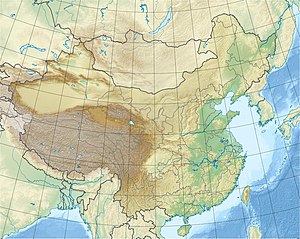Sanmenxia Dam
| Sanmenxia Dam | |||||||
|---|---|---|---|---|---|---|---|
| Dam of the Sanmenxia dam | |||||||
|
|||||||
|
|
|||||||
| Coordinates | 34 ° 49 '42 " N , 111 ° 20' 45" E | ||||||
| Data on the structure | |||||||
| Construction time: | 1957-1960 | ||||||
| Height above foundation level : | 108 m | ||||||
| Crown length: | 713 m | ||||||
| Power plant output: | 100 MW | ||||||
| Data on the reservoir | |||||||
| Water surface | 2 350 km² | ||||||
| Storage space | 35,400 million m³ | ||||||
| Dam of the Sanmenxia dam | |||||||
The Sanmenxia Dam on the Yellow River (Huang He) in the east of Henan Province in China is the largest dam in East and Southeast Asia after the storage space and the first dam built on the Yellow River.
history
The 108 meter high gravity dam was built from April 1957 to September 1960 with Soviet advice at the city of Sanmenxia and was considered a great achievement by revolutionary China. It should protect against flooding , generate energy from hydropower and serve for irrigation . It was one of the prestigious major projects of the Great Leap Forward , even if planning began before this campaign began. The project was criticized , among others, by the US-trained engineer and hydrologist Huang Wanli , who pointed out that the Yellow River would fill the reservoir with sediment very quickly. Mao Zedong himself attacked Huang Wanli in an editorial published in June 1957 by Renmin Ribao, accusing him of harming the party, of promoting bourgeois democracy and of admiring foreign cultures.
There are very different details about the size of the original storage space. The sources speak of 5.89, but also of 35.4 and even 96 km³ (billion cubic meters). The most believable number is the middle one (35.4). In the original plans, a maximum water level of 360 m above sea level, a storage capacity of 64.7 billion m³, an installed electrical output of 1160 MW and resettlement of 870,000 people were planned.
The reservoir is now largely filled with sediment because the sludge from the Yellow River is deposited in large quantities. Huang Wanli had warned against this. However, it was ignored in the planning and initially there were no openings in the dam wall to flush the lake. In 1964, a large part of the storage space (around 60%) was silted up. Every year it filled with another 10 billion m³. At times the dam had less than 10% of the original storage space. The sediments also prevent the turbines in the hydropower plant from generating electricity because they become clogged. As a result, actual electrical output is estimated to be 100 MW or less (statistics are not disclosed).
This problem is countered with flushing in the rainy season when the water level is lower. In this way it is possible to let the sediments carried in through and even to flush out sediments that have already been deposited. In several phases, additional openings at different heights were built into the dam, the first in 1968, and more until 1978. From November to June, when there is no flood, water and mud are stored and during the flood period from July to October the water level is 16 m lowered and the reservoir flushed.
The reservoir is between 400 m and 5800 m wide.
See also
- List of hydropower plants in China
- List of dams in China
- List of the largest dams on earth
- List of the largest reservoirs on earth
literature
- Judith Shapiro: Mao's War Against Nature - Politics and the Environment in Revolutionary China . Cambridge University Press, Cambridge 2001, ISBN 0-521-78680-0 .
Web links
Single receipts
- ^ Frank Dikötter: Mao's Great Famine: The History of China's Most Devastating Catastrophe, 1958–1962 . Bloomsbury, London 2010, ISBN 978-1-4088-1219-8 , p. 26.
- ↑ Christoph Behrens: Mao's monster. A dam was supposed to curb China's fate - and has only caused trouble for decades. In: Süddeutsche Zeitung of December 29, 2016, p. 16.


